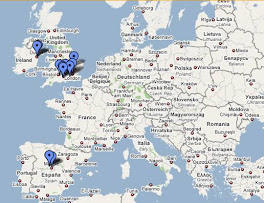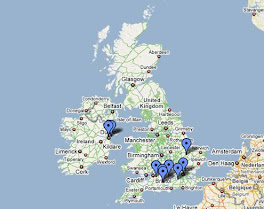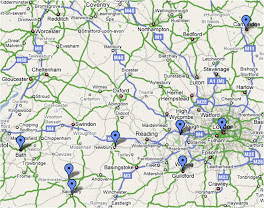To round out our tour of England, Bill and I thought that it was time to stray from the London scene for a weekend and check out another of Britain's famous cities: Cambridge. Located north of London, Cambridge is the home of England's most prestigious university. Second in the world to only Harvard, Cambridge University has a history that quickly overshadows its American rival. Wondering what the city had to offer, Bill and I grabbed a train and headed northeast.
The hardest part of the two-and-a-half hour train ride to Cambridge was actually getting to the Guildford train station to start our journey. Partying pretty hard the night before, Bill forgot to set an alarm and woke up only to my phone call to see if he was ready to go. Since he needed a few extra minutes to get himself going that morning, I waited at the train station until he eventually meandered through the gates. (Though he may have wanted more sleep, my adrenaline was pumping after only two hours of shut-eye... my mentality is "tour now and crash later".) Eventually, we caught a train to London Waterloo station for the first leg of our journey.
Like airlines, longer train trips are often cut into parts with transfers at various stations. For this trip, we took a train from Guildford to London Waterloo, rode the subway from Waterloo to London Kings Cross Station, hopped on another train from Kings Cross to Royston, and then took a bus from Royston to Cambridge. Transferring from one mode of transportation to another can be a mess if you don't know what you're doing, but thankfully, Bill and I have had enough experience with public transportation to get ourselves easily from city to city. The best part about the transfer hassle was the chance to visit London Kings Cross Station. For those of you outside the Harry Potter loop, Kings Cross Station is the train station where wizards and witches are able to travel by train to various places in the magical community. Most notably, Kings Cross Station is the home to Platform Nine-and-Three-Quarters where Harry Potter catches his first train to Hogwarts School of Wizardry and Witchcraft. As the story goes, the platform is magically disguised so that Muggles (non-magical people) pass by without knowing that the platform even exists -- to them, Platform Nine-and-Three-Quarters is only a brick wall of seemingly no importance. Wizards, however, are able to step onto the platform by running head-first into the wall where they are magically transported to their awaiting train. In honor of the famous book series by J.K. Rowling, Kings Cross Station erected a brick wall and named it "Platform Nine-and-Three-Quarters". The best part about the wall is the luggage cart that is disappearing into it as if a wizard got stuck halfway between the magical world and ours. In short, this was just another great photo opportunity to snap a few fun pictures of something seen only in London.
Eventually, we arrived at the Cambridge train station just in time for lunch. Hitching a bus to the middle of the city, we started our search for a picturesque park bench that would suffice for munching on a few sandwiches. So we searched... and searched... and searched... and eventually gave up when we realized that the only benches in Cambridge were a few remote park benches near museums and other major city sites. Planting ourselves in front of the Fitzwilliam Museum, we marveled at the fact that Britain's most prestigious university could be so unfriendly to out-of-town picnickers. Walking through the city, we found signs posted on nearly every patch of green space proclaiming, "DO NOT STEP ON THE GRASS!" Needless to say, the lack of public grass patches gave me a twinge of longing for the student-infested lawns back home in Cincinnati.
Trying to blow a little time before our Cambridge tour at 1:30 p.m., Bill and I stepped into the Fitzwilliam Museum for a few minutes to see another collection of ancient artifacts and pieces of civilization. After touring several museums in England, I've become rather picky about exhibits. As a result, there were only a few items that truly interested me in this museum, but I must say that they were pretty spectacular items. Though Bill was a big fan of the medieval swords and armor, I preferred the Chinese fan exhibit and one very spectacular Renaissance sculpture. "Adoration of the Magi" is a sixteenth century masterpiece carved in white alabaster stone. The detailing was phenomenal, and its preservation was impeccable. The interesting thing that I've noticed with Renaissance art is that artists had a tendency to dress biblical characters in the clothes of their own time period. Despite thinking that this sculpture was magnificent, I chuckled to see the three wise men wearing Flemish hats with large plumes.
Cutting our visit to the museum a little short, Bill and I rushed off to catch our two-hour tour of Cambridge University and Kings College Chapel. Unknown to most Americans, Cambridge University is actually a large collection of "colleges". In the U.S., "colleges" that comprise an university generally include the "College of Engineering", "College of Business", "College of Performing Arts", etc. At Cambridge, however, colleges are much less logically defined. The history of Cambridge begins with the university's largest rival -- Oxford. During the era of the Black Plague, students left Oxford University to settle in Cambridge in hopes of escaping the perpetually spreading plague. (Yes, that's right! Oxford came before Cambridge.) Unable to control the sudden influx of students, various townspeople in Cambridge began establishing colleges to keep the students occupied and out of trouble. You may ask, "Why would townspeople want to spend large amounts of money on colleges that they would never use themselves?" At that time, all colleges were associated with a chapel in which students were required to pray for their benefactor's soul to be spared from Purgatory. For wealthy widows, this was one of the few means by which they could achieve financial independence and spend their husband's money. A widow could put money into a college, and students would then pray for the soul of her husband (whether or not prayer was the main motivation for the widow's financial independence is still up for debate). With this in mind, most of the colleges were founded by very wealthy widows living in Cambridge. Corpus Christi College, however, was founded by the townspeople of Cambridge. With the Black Plague spreading throughout England, Cambridge was not spared from illness and death. Taking the money from the townspeople who had died in the plague, the remaining citizens of Cambridge built Corpus Christi College in honor of the dead. This college was important because it meant that the students would be required to pray for the souls of those killed by the Black Plague. Though it might sound a little silly to American separation of church and state, this rule was enforced and proved to be major motivation in the founding of additional colleges in Cambridge. Today, all of the colleges are encompassed until the title of "Cambridge University". However, each applicant may apply for admittance to only one of the colleges within the university. The desired course of study is irrelevant since each college selects a set number of students from each major. There is a lot of strategy in picking a college because some are more prestigious than others. If your main goal is to get a diploma from Cambridge University, then you would apply for a less competitive college. If you want the highest level of prestige behind your name, then you would study like a manic and keep your fingers crossed that Kings College glances at your application. This education system is a bit confusing, but I can't say much against it considering that Cambridge U. is the second best university in the world.
Lucky for us, admission into Kings College Chapel was included with our tour of the colleges. King Henry VI commissioned the building of Kings College Chapel in an effort to "best the pope". (The stubborn feud between the Church of England and Catholicism rears its head once again in history.) Since the pope could boast of the Sistine Chapel in Rome, King Henry wanted and even bigger church with more impressive ceiling than that found in the Vatican. Who knows which church leader actually won the competition of church ceilings, but I should be able to give an opinion after visiting Rome next month. Needless to say, Kings College Chapel earns its right to be the largest fan-vaulted ceiling in the world. The only aspect more magnificent than the ceiling are the stained glass windows. Despite years of war, the original 16th century stained glass windows remained intact. Beyond their beauty, these windows have a real story to tell. During World War II, the townspeople of Cambridge removed the windows from their original places in the church and stored them away for safe-keeping. Once peace was restored once again, they painstakingly replaced the windows back to their original homes. Unlike most churches where stained glass windows haphazardly erected to depict random biblical stories, these windows have an interesting logical progression. Each large window is divided into ten sections -- five on top and five on bottom. The bottom section depicts stories from the New Testament with most occurring after the birth of Christ. Two different stories are depicted in this bottom section. One story is illustrated in the two rightmost panes while the other is shown in the two leftmost panes. The middle pane is reserved for pictures of two townspeople holding scrolls with descriptions in Latin of the biblical stories located in that particular window. The interesting part to this arrangement is that the upper five panes of the window are designed exactly the same with Old Testament stories -- two stories separated by a central pane with scroll-holding people. You may be asking, "So what?! Why is this important?" The neat part about this lies in the placement of the Old Testament stories on top of the New Testament stories. The Old Testament story located directly above a given New Testament story is the exact antitype of the after-Christ version. For example, one window had two lower panes depicting the Annunciation where Mary was visited by the angel Gabriel and agreed to give birth to Christ Jesus, thus agreeing to the will of God. Directly above these panes is the Old Testament antitype of Eve giving in to the serpent in the Garden of Eden and eating a piece of fruit from the tree forbidden by God, thus rejecting the will of God. Another type/antitype depiction was Jesus rising from the tomb three days after his burial after completing the will of God while the Old Testament version directly above showed Jonah rising from the belly of a whale after running from the will of God. Religious or not, most people will admit that these windows are pretty cool.
Finishing up our Cambridge University tour, Bill and I headed towards the River Cam for the main highlight of our trip -- PUNTING! For those of you who are unfamiliar with boating, punting is essentially a way of pushing a rowboat down a river with only a long pole. Getting slightly burnt out on museums and historical tours, we were ready for an active cultural experience! After renting a boat and watching a few punters push their punts around in the water, we felt pretty confident to try our luck with one of Cambridge's most well-known pastimes. Giving in to the gentlemanly phrase of "ladies first", Bill took a seat in the middle of the boat while I situated myself with the punting pole. Like most things that I attempt for the first time, I had no beginner's luck with a pole, a boat, and a river full of water. In short, I merely managed to spin our boat in a perpetual circle with no idea how to steer the vessel with only a metal pole. To make matters worse, several drunken Englishmen thought that it would be funny to taunt me from a nearby bridge. Feeling my face flushing with embarrassment, I tried to make the best of the situation by coquettishly smiling their way and giving them a flirtatious wink. Laughing, they yelled a few words of encouragement, which were unfortunately lost in the wind. Giving up, I handed the pole to Bill in hopes of actually getting our boat away from the dock. Expecting him to face the same problems that I experienced, I was impressed and slightly frustrated that he picked up the skill without much trouble at all. Burying the frustration with myself, I took the chauffeured opportunity to snap a few scenic pictures of the river. Once Bill's arms had tired, I was ready for a second chance to redeem myself on the punt. Learning from my original mistakes, I mustered up the courage to stand on the very back of the boat in order to have better steering control. This time, it took me only minutes to master the art of pushing our boat to downstream and back again without any major disasters. Take that, taunting Englishmen on the bridge!
With tired arms and damp clothing, Bill and I were ready for our final Cambridge destination -- The Eagle. This pub is the famous hang-out spot for Watson and Crick, the scientists who discovered the structure of DNA. (To be completely fair, Watson and Crick only created the first model of DNA and hence noticed that it formed a double-helical structure. A majority of the work leading up to this discovery was completed by Rosalind Franklin, who died from excessive radiation exposure utilized to complete her work.) Upon mastering the first DNA model, Crick ran to the Eagle and exclaimed, "We have discovered the meaning of life." Today, the Eagle is a fully functioning bar and restaurant that is constantly filled with tourists and college kids looking for a cool drink or tasty meal. For Bill and I, we were looking for a bit of authentic British cooking. With several dishes to choose from, I eventually settled on "bangers and mash", which is English sausage on top of mashed potatoes and covered with gravy. Though most people at home had warned me that British food is not much to boast about, I was incredibly impressed with this English dish. Though I may be denouncing my German heritage, I might even prefer British sausage to bratwurst!
Overall, our day in Cambridge was a fun one. The colleges were neat to see, and Kings College Chapel is another example of beautiful European churches. Rich in history, the city is best appreciated with a good tour or a lot of research prior to visiting. However, my favorite memory will definitely be punting on the River Cam.
After five weeks in England, Bill and I have managed to tour three major British cities (London, Bath, and Cambridge) and are now ready to start tackling the rest of Europe. This upcoming weekend, we're hopping off the island to visit the founding city of Guinness beer. May the luck o' the Irish be with us in DUBLIN!
Tuesday, October 9, 2007
Subscribe to:
Post Comments (Atom)











No comments:
Post a Comment